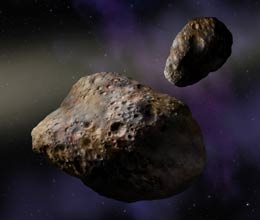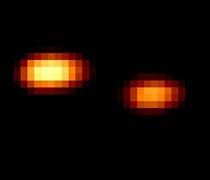
Artist Lynette Cook depicts the Trojan asteroid 617 Patroclus and its companion, which has been tentatively named Menoetius. The two bodies are 122 and 112 kilometers (76 and 70 miles) wide, respectively, and orbit each other every 4.3 days. They are separated by about 680 km. Click on the image to view a larger version.
Courtesy Lynette Cook / W. M. Keck Observatory.
Thousands of Trojan asteroids circle the Sun in Jupiter's orbit roughly 60 degrees ahead of and behind the giant planet itself. These small bodies inhabit Jupiter's L4 and L5 Lagrangian points, zones of stability where a small body can maintain its position with respect to the two larger bodies. But where did these Trojans come from?
Spectral observations have shown clear similarities between the Trojans (which are named after Greek and Trojan heroes in Homer's epic The Iliad) and the distant worlds of the Kuiper Belt. In this week's issue of Nature, a French and American team led by Franck Marchis (University of California, Berkeley) provides new observational support that the Trojans did indeed originate in the Kuiper Belt, and were later captured into their Jupiter-leading and -trailing orbits.
Using the 10-meter Keck II Telescope in Hawaii, Marchis and 17 colleagues observed the only known binary Trojan, 617 Patroclus, on five nights between November 2004 and July 2005. By employing Keck's new laser-guide-star adaptive-optics system to counteract atmospheric turbulence, they resolved the bodies and determined their orbits. This, in turn, enabled the group to make the first direct density calculations for Trojan asteroids.

On May 28, 2005, the Keck II Telescope acquired this image of 617 Patroclus, the only known binary Trojan asteroid. Adaptive optics using a laser guide star allowed the telescope to resolve the two bodies, which are a scant 150 milliarcseconds apart. The binary might be the wreckage of a single comet that was tidally ripped into two parts billions of years ago during a close encounter with Jupiter.
Courtesy Franck Marchis / W. M. Keck Observatory / Nature and others.
The two bodies have densities of only 0.8 gram per cubic centimeter, which is way too low for a rocky, asteroid-like object, unless they are extremely porous. The low densities strongly suggest that both bodies are made primarily of water ice, with perhaps a coating of dirt. This is the same bulk composition of comets and small Kuiper Belt objects.
The density measurements offer compelling observational support for a model developed last year by Alessandro Morbidelli (Observatory of the Côte d’Azur, France) and three colleagues. Their computer simulations showed that Jupiter and Saturn jumped over a 2:1 resonance in the solar system's early history (a 2:1 resonance means one body orbits the Sun twice every time the other one goes around once). The simulations further showed that this relationship opened a dynamical doorway that allowed Jupiter's gravity to capture large numbers of inbound Kuiper Belt objects into Trojan orbits.
"This is the first time anyone has determined directly the density of a Trojan asteroid, and it supports the new scenario proposed by Morbidelli," says Daniel Hestroffer (Paris Observatory, France), a member of Marchis's team.

The Trojan asteroids lie roughly 60 degrees ahead of and behind Jupiter in its orbit.
Courtesy IMCCE / University of California, Berkeley.
"Theorists like me are criticized for not coming up with predictions," says Hal Levison (Southwest Research Institute, Colorado), a member of Morbidelli's team. "But in hindsight, this observation seems to support our model. The more we look at Trojans and Kuiper Belt objects, they should look the same, and indeed they do."
Marchis himself adds, "We need to discover more binary Trojans and observe them to see if low density is a characteristic of all Trojans." Marchis and his colleagues proposed the name Menoetius for the companion, and the International Astronomical Union has tentatively accepted it.
In another Nature paper about the Kuiper Belt published this week, Frank Bertoldi (University of Bonn, Germany) and four colleagues report thermal observations taken with the Institute for Millimeter Radio Astronomy's 30-meter telescope in Spain that confirm that the distant object 2003 UB313 is indeed larger than Pluto. By comparing UB313's brightness and reflectivity, Bertoldi and his colleagues measure a diameter of about 3,000 km, which is 700 km larger than Pluto's. These results are consistent with previous Spitzer Space Telescope observations of this so-called "tenth planet" that were announced four months ago. "Since UB313 is decidedly larger than Pluto," says Bertoldi, "it is now increasingly hard to justify calling Pluto a planet if UB313 is not also given this status."
 0
0
Comments
You must be logged in to post a comment.